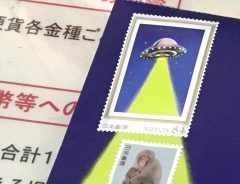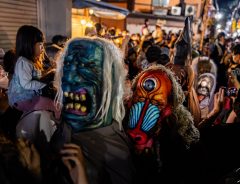
Source: さきゅう Sakyu (@shamo0301) - image used with permission
Japanese artist & illustrator Sakyu creates yōkai monsters from modern objects and phenomena
- Tags:
- japanese illustrator / Sakyu / supernatural / Yokai
Related Article
-

Yokai of Japan: Top 6 Demons and Mythical objects you can find in Chiba Prefecture
-

Illustrator gozz imagines what lurks beneath an onsen’s cold water tub [thalassaphobia alert]
-

Slit-mouth woman and other Japanese ghouls turned into traditional sweets
-

Japanese illustrator leaves his creative stamp and a good dose of UFO humor on an envelope
-

Japan’s Night Parade of One Hundred Demons returns in terrifying force after three year hiatus
-

Life, Death and Dreams: The Beautiful and Fashionable Art of Shikimi


Yōkai old and new
Yōkai 妖怪 are supernatural entities and spirits from Japanese folklore. Deeply tied to the Japanese animistic belief that spirits inhabit all things, whether living or not, yōkai can take on humanoid features like the zashiki-warashi, animal features like the kappa (water imp) or the plague-fighting Amabie, recently revived due to the pandemic, and even inanimate objects such as tools.
However, yōkai don't represent a fixed and unchanging cast of characters. As the times have changed, new members have been added. Urban legends like kuchisake-onnna (the slit-mouth woman) or Hanako-san, a ghostly girl who haunts school toilets, joined the roster in the Showa Period. Moreover, it's only natural to consider that the subclass of tsukumogami, yōkai based on tools, would see additional members join their ranks as new tools appear with the changing times.
Sakyu's contemporary yōkai
Japanese artist and illustrator Sakyu has a fertile imagination when it comes to yōkai. Paying homage to the artistic style and the visual conventions of yōkai woodblock prints, she enjoys creating entirely new yōkai based on modern objects and phenomena. Through the clever design, concept, and naming of the yōkai to the creative use of the limited color palette to make striking compositions, Sakyu creates perceptive and thought-provoking works updating yōkai to the Reiwa Era.
In addition to providing illustrations for books, websites, posters, and goods, Sakyu has exhibited her work in Osaka, Japan, and internationally. For example, her work was featured in the "Enfers et fantômes d'Asie" exhibition at the Quai Branly Museum in Paris (2018) and at the "Yōkai: Ghosts & Demons of Japan" exhibition at the Museum of International Folk Art in Santa Fe (2019).
Selected works
With Sakyu's gracious permission, we'd like to introduce four of our favorite yōkai along with her comments explaining ther origin stories.
Kuchi-ōi 口覆い
Name: Kuchi-ōi 口覆い, means "face covering"
Image reproduced with permission from さきゅう Sakyu (@shamo0301)
"There was a time when I often saw used facemasks littering the streets, perhaps due to the effects of the novel coronavirus pandemic. When I made this illustration, there was a drop in the supply of masks in Japan. I thought it was wasteful to throw away masks like that, so I drew this yōkai."
Fumi-sarashi 文曝し
Name: Fumi-sarashi 文曝し, means "letter revealer."
On her Twitter account, Sakyu explains that this yōkai enjoys taking letters deposited in its mouth and revealing their content as rumors to spread throughout the neighborhood. They particularly enjoy sappy love letters.
Image reproduced with permission from さきゅう Sakyu (@shamo0301)
"These days, people have very few opportunities to send letters through a mailbox. I'm sure mailboxes are feeling lonely..."
Note: Modern post boxes are usually square or rectangular, but they used to be cylindrical like this:
Lover of Romance, CC BY-SA 3.0, via Wikimedia Commons
Shike-mokuren 四火煙連
Name: Shike-mokuren 四火煙連, is difficult to translate, but could be read as "bringer of fire and smoke."
Sakyu explains that it's an evil dragon formed out of discarded lit cigarettes. Exhaling poisonous fumes, it leaves fires in its wake. They often appear in the mountains when people are careless with their smoking, and cause wildfires that quickly burn the area to the ground.
Image reproduced with permission from さきゅう Sakyu (@shamo0301)
"In Japan, the penalties for smoking on the street are increasing. However, I still see cigarette butts on the street. It's really important to stop littering."
Me-kujira 目くじら
Name: Me-kujira 目くじら. This is a clever play on words. In Japanese, blaming others for their faults can be conveyed through the expression 目くじらを立てる mekujira wo tateru. It literally means "raising the outer corner of one's eyes," as one does when displaying an angry, disapproving frown. Mekujira means the outer corner of the eye, but it also contains the word 鯨 kujira, meaning whale.
Sakyu explains that Me-kujira are yōkai that ride on waves of anger. Whether in the virtual world or in the real world, those who are consumed by anger fall victim to the Me-kujira and are pursued by this yōkai until they take their anger out on someone else.
Image reproduced with permission from さきゅう Sakyu (@shamo0301)
"Sometimes I see people who seem to be angry about everything. These people are surely eaten alive by Me-kujira."
Sakyu has many more appealling yōkai illustrations on her Twitter account and her Tumblr page, so please follow her and take a look. You can contact her at toritoru0301@gmail.com.